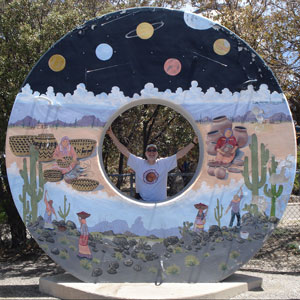
John Heasley stands inside the “giant bagel”, a concrete replica of the mirror in the largest of the Kitt Peak telescopes. The mural embellishment reflects a creative moment and does not appear on the real mirror. The photo was taken by Heasley’s fellow teacher Evan Gnam. They joined two UW-Madison astronomers and two pre-service students to learn about the work of researchers at the observatory.
High above Arizona’s Sonora Desert on Kitt Peak, the night sky is clear and ideal for stargazing, especially if viewed through the WIYN telescopes. In May 2010, scientists from the University of Wisconsin-Madison Astronomy Department in the College of Letters & Science arranged for two high school teachers and two pre-service teachers to spend time at the WIYN Observatory learning first-hand about the telescope and the work of researchers there. These teachers, in turn, are now opening the wonders of astronomy for their students and neighbors back in Wisconsin. While distant galaxies are certainly an exciting area of study, equally amazing is that the cost of this learning experience for six people was less than $4,000. Funding was provided primarily from the Astronomy Department, the school districts and the Astronomy Board of Visitors.
Madison East High School math, physics and astronomy teacher Evan Gnam (’97 MS L&S) and Richland Center High School English teacher John Heasley, along with UW-Madison pre-service teachers Derek Engebretson and Brandon Olszewski joined UW-Madison astronomers and trip organizers Marsha Wolf and Eric Hooper on the trip. Engebretson has since graduated and is now teaching; Olszewski will graduate in spring 2011. They were the first pre-service teachers to participate in this type of trip.
The teachers made images of some of their favorite objects in the sky such as nebulae formed by dying stars, globular and open star clusters, distant galaxies like the Whirlpool Galaxy and even clusters of galaxies. They are incorporating their experience into lesson plans. In addition, they contributed to a UW-Madison research program to estimate the masses of black holes in distant galaxies and discern how these black holes might have been connected to the history of the formation of stars over billions of years.
“We gave them a chance,” said Hooper, “to share in this process so that they would be better equipped to teach their students about science. A very important issue in science education and literacy (or lack thereof) in the United States is the misperception that science is nothing more than a grab bag of disparate facts delivered by authority and whose validity depends on one’s political persuasion. Rather, it is a somewhat systematic process by which almost child-like curiosity leads to greater understanding of the universe and everything in it.”
Ten months after the trip, John Heasley shared his reflections. “I was wowed by the experience of typing in the celestial coordinates, having the 36-inch telescope slew precisely to its destination, collecting the photons that had traveled millions of years and seeing the Whirlpool Galaxy appear on the screen. I understand better not only how astronomers gather data, but why they do it.
“Astronomers are uncovering some of the most exciting stories of our generation when it comes to our origins, our futures and our place in the cosmos. Much of this work is happening ‘on the mountaintop’ at isolated locations such as Kitt Peak. As a result of this trip, I feel much more confident in sharing these stories with the public and in my courses and in public outreach events.
“Specifically, I have been able to tell people the story of how astronomers are able to learn so much from a ‘handful’ of photons. I saw first-hand how researchers formulated a question, decided on the destinations for study, gathered light and then processed that light. Sometimes public outreach events and news stories focus on the product, such as a finished picture from the Hubble. From my Kitt Peak experience, I am able to tell the story of how a picture came to be and the processes used to create the image. I saw first-hand how scientific research was being conducted at one of the best laboratories.”
Evan Gnam also shared his experience with his students. “I have shown my pictures from the trip to each class. They really appreciate seeing what a modern observatory looks like and it has to mean a lot that they see their teachers as continuous learners and partners in the scientific endeavor, even if most of the time we are in the schools.”
That’s a pretty good return on a $4,000 investment.
The WIYN Consortium owns and operates two telescopes at Kitt Peak National Observatory near Tucson, Arizona. The group includes the UW-Madison, Indiana University, Yale University and the National Optical Astronomy Observatory for the 3.5-meter telescope. Several other partners are involved in the 0.9-meter telescope, including UW System schools Madsion, Oshkosh, Stevens Point and Whitewater plus the Wisconsin Space Grant Consortium.
